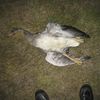16.6.2023 | 12:42
Hvađ segir AI um forvarnir á lúsmý?
Culicoides reconditus, commonly known as biting midges or no-see-ums, are small flying insects known for their painful bites. While there isn't a specific repellent designed to kill Culicoides reconditus, you can use repellents to deter them from biting. Here are some recommendations for repelling and reducing the presence of these insects:
DEET-based repellents: Products containing N,N-diethyl-meta-toluamide (DEET) are effective against Culicoides reconditus. Look for repellents with a concentration of 20% to 30% DEET, as higher concentrations don't necessarily provide significantly longer protection. Follow the instructions on the product for safe and effective use.
Picaridin-based repellents: Repellents containing picaridin are another good option for repelling biting midges. Picaridin is less greasy compared to DEET and has a milder odor. Look for products with a concentration of 10% to 20% picaridin.
IR3535-based repellents: Insect repellents containing IR3535 (ethyl butylacetylaminopropionate) can also provide protection against biting midges. Choose products with a concentration of around 20%.
Permethrin-treated clothing: Consider treating your clothing, such as shirts, pants, and socks, with permethrin. This insecticide repels and kills insects upon contact. Make sure to follow the instructions for application and reapplication, as permethrin-treated clothing usually maintains its effectiveness through multiple washes.
Avoid peak activity times: Biting midges are most active during dawn and dusk. If possible, limit your outdoor activities during these times to reduce exposure to the insects.
Wear protective clothing: Cover exposed skin by wearing long sleeves, long pants, socks, and closed-toe shoes. Additionally, choose light-colored clothing, as dark colors tend to attract these insects.
Use physical barriers: If you have a patio or outdoor area, consider using fine-mesh screens or netting to create a barrier between you and the biting midges.
It's important to note that while repellents can be effective, they may not provide complete protection. Additionally, environmental control measures, such as eliminating standing water sources where midges breed, can help reduce their population in your vicinity. Consulting with a local pest control expert or entomologist can provide more specific advice based on your location and the severity of the infestation.

|
Lúsmýiđ er mćtt |
| Tilkynna um óviđeigandi tengingu viđ frétt | |
Fćrsluflokkar
Eldri fćrslur
- Júní 2023
- Júní 2020
- Mars 2018
- Desember 2012
- Desember 2011
- Október 2011
- Október 2010
- Júní 2010
- Apríl 2010
- Mars 2010
- Febrúar 2010
- Janúar 2010
- Desember 2009
- Nóvember 2009
- Október 2009
- September 2009
- Ágúst 2009
- Júlí 2009
- Júní 2009
- Maí 2009
- Apríl 2009
- Mars 2009
- Febrúar 2009
- Janúar 2009
- Desember 2008
- Nóvember 2008
- Október 2008
- September 2008
- Ágúst 2008
- Júlí 2008
- Maí 2008
- Apríl 2008
- Mars 2008
- Febrúar 2008
- Janúar 2008
- Desember 2007
- Nóvember 2007
- Október 2007
- September 2007
- Júlí 2007
- Júní 2007
- Maí 2007
- Apríl 2007
- Mars 2007
- Nóvember 2006
Bloggvinir
-
 godsamskipti
godsamskipti
-
 gummisteingrims
gummisteingrims
-
 andres
andres
-
 dofri
dofri
-
 sigmarg
sigmarg
-
 gattin
gattin
-
 agustolafur
agustolafur
-
 ellyarmanns
ellyarmanns
-
 emmgje
emmgje
-
 finnurtg
finnurtg
-
 tommi
tommi
-
 hipporace
hipporace
-
 arnheidurmagg
arnheidurmagg
-
 formula
formula
-
 baldvinj
baldvinj
-
 launafolk
launafolk
-
 dullur
dullur
-
 gisgis
gisgis
-
 eirikuro
eirikuro
-
 erla
erla
-
 folkerfifl
folkerfifl
-
 fridrikof
fridrikof
-
 ulfarsson
ulfarsson
-
 gerdurpalma112
gerdurpalma112
-
 gudni-is
gudni-is
-
 gullvagninn
gullvagninn
-
 jarnskvisan
jarnskvisan
-
 id
id
-
 fun
fun
-
 jamesblond
jamesblond
-
 jonthorolafsson
jonthorolafsson
-
 juliusvalsson
juliusvalsson
-
 ludvikludviksson
ludvikludviksson
-
 magnusmar
magnusmar
-
 marinogn
marinogn
-
 maggimur
maggimur
-
 hux
hux
-
 rrs
rrs
-
 sigurdurkari
sigurdurkari
-
 siggisig
siggisig
-
 sigurgeirorri
sigurgeirorri
-
 sigurjons
sigurjons
-
 snorrima
snorrima
-
 spurs
spurs
-
 vala
vala
-
 thordisb
thordisb
-
 tbs
tbs
-
 thrudur
thrudur
-
 vitinn
vitinn
Tenglar
Frábćr myndbönd
- Frábært gamalt myndband frá Jeremy Clarkson um Ísland Nokkuđ skemmtileg afţreying!
Hversu biluđ erum viđ?
http://www.psychiatry24x7.com/
Heimsóknir
Flettingar
- Í dag (7.10.): 3
- Sl. sólarhring: 5
- Sl. viku: 10
- Frá upphafi: 98580
Annađ
- Innlit í dag: 3
- Innlit sl. viku: 10
- Gestir í dag: 3
- IP-tölur í dag: 3
Uppfćrt á 3 mín. fresti.
Skýringar





Bćta viđ athugasemd [Innskráning]
Ekki er lengur hćgt ađ skrifa athugasemdir viđ fćrsluna, ţar sem tímamörk á athugasemdir eru liđin.